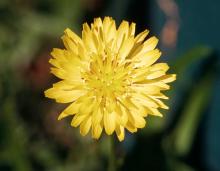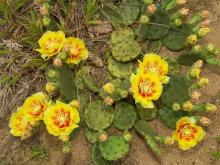Wildflowers, Grasses and Other Nonwoody Plants
Media

Species Types
Scientific Name
Packera obovata (formerly Senecio obovatus)
Description
Most common in the Ozarks, round-leaved groundsel is one of seven Packera species in our state. Its showy, bright yellow, daisylike flowers form flat-topped clusters that arise from sparsely leaved stems.
Media

Species Types
Scientific Name
Pyrrhopappus carolinianus
Description
One of several native plants called dandelions, Carolina false dandelion is an annual with sulphur yellow flowers and puffy seedheads.
Media

Species Types
Scientific Name
Krigia biflora
Description
There are several members of the aster family that look something like common dandelions. But unlike the familiar lawn weed, two-flowered Cynthia is a native Missouri wildflower.
Media

Species Types
Scientific Name
Hieracium gronovii
Description
A native wildflower of forests, blufftops, glades, pastures, and roadsides, beaked hawkweed looks something like a hairy, yellow-flowering chicory. It is found mostly south of the Missouri River.
Media

Species Types
Scientific Name
Heterotheca camporum (syn. Chrysopsis villosa var. camporum)
Description
Golden aster can cover entire valleys with its bright yellow flowers. It blooms June through October and is scattered mostly south of the Missouri River.
Media

Species Types
Scientific Name
Verbesina helianthoides
Description
Yellow crownbeard and its close relatives are called wingstems because of lengthwise, winged ridges along the stems. Look for it blooming, May through October, in open and rocky areas.
Media

Species Types
Scientific Name
Tragopogon dubius
Description
With its yellow composite flowers and round seedheads of fluffy “parachutes,” goat’s beard looks like a gigantic dandelion. A native of Europe, many people view it as an invasive weed.
Media

Species Types
Scientific Name
Potentilla recta
Description
Rough-fruited cinquefoil is common in most of North America in fields and pastures, along roadsides, and other disturbed areas. It’s a stout, tall, hairy plant with five yellow to cream-colored, slightly notched petals.
Media

Species Types
Scientific Name
Opuntia humifusa (formerly O. compressa)
Description
Cacti make us think of the desert southwest, but there is at least one species native to Missouri. This prickly pear grows in glades, sand prairies, rocky open hillsides, and other dry, sun-soaked areas.
Media

Species Types
Scientific Name
Asclepias viridis
Description
The flower clusters of green-flowered or spider milkweed bear large flowers for a milkweed. The jazzy purple hoods are dazzling against the greenish-yellow petals.
See Also
About Wildflowers, Grasses and Other Nonwoody Plants in Missouri
A very simple way of thinking about the green world is to divide the vascular plants into two groups: woody and nonwoody (or herbaceous). But this is an artificial division; many plant families include some species that are woody and some that are not. The diversity of nonwoody vascular plants is staggering! Think of all the ferns, grasses, sedges, lilies, peas, sunflowers, nightshades, milkweeds, mustards, mints, and mallows — weeds and wildflowers — and many more!





















